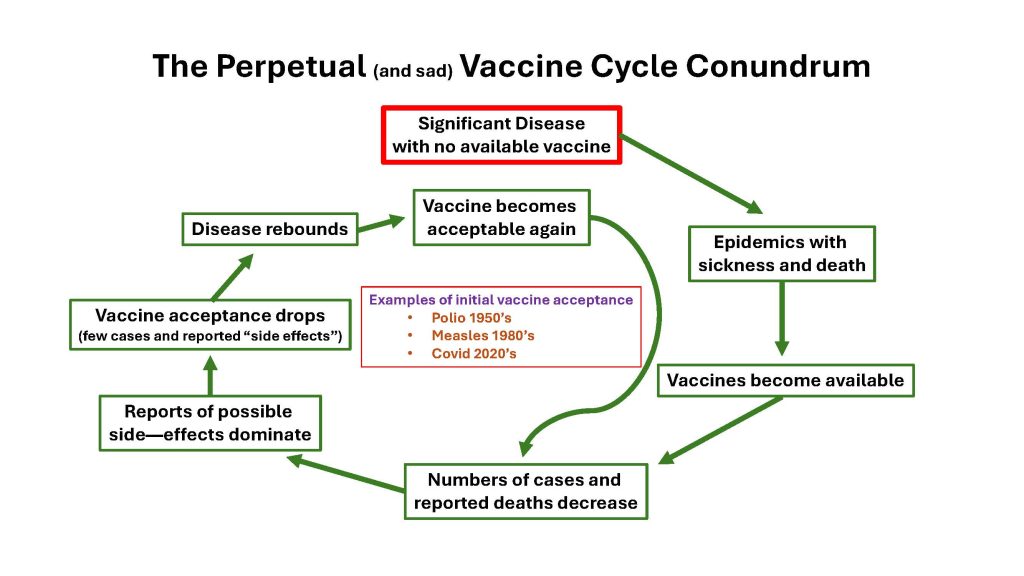Measles, a highly contagious viral infection, has plagued humanity for centuries, its origins dating back to ancient times. Despite advancements in medical science, measles remains a significant threat in today’s world, particularly in regions with limited access to healthcare and vaccination programs. As recently as February 2024, deaths from measles have been reported in Burkina Faso, with an increase in confirmed cases being reported in Iraq, to name just two countries that have been affected.
Cover against Measles in Ireland was introduced in the mid 1980’s. Prior to that time many within the population contracted the disease and that itself gave those individuals long-lasting protection through natural immunity.
The hysteria in the early 2000’s suggested that the MMR vaccine (Measles, Mumps and Rubella) was related to autism and other significant problems. This led many parents to not allow their children to be vaccinated against these serious diseases. Subsequently many teenagers and those in their early 20’s in Ireland have now recently succumbed to these diseases.
There is a clear ‘viscous circle’ which can be linked to a population’s acceptance of various vaccinatable diseases. Most recently we have seen that with COVID-19 but with cover against MMR that has also sadly been seen too frequently.

Understanding the origins, causes, symptoms, and dangers of measles is crucial for combating its resurgence and protecting vulnerable populations, especially in the third world.
Origins and Causes of Measles
The history of measles traces back to at least the 9th century, with early descriptions found in ancient writings. The causative agent, the measles virus, belongs to the paramyxovirus family and primarily spreads through respiratory droplets. The virus can survive in the air and on surfaces for several hours, making transmission highly efficient, especially in crowded or unhygienic conditions.
Measles outbreaks occur predominantly in areas with low vaccination rates, where the virus can quickly spread among susceptible individuals. Factors contributing to low vaccination rates include inadequate healthcare infrastructure, misinformation about vaccines, and logistical challenges in reaching remote communities.
Measles Symptoms
The symptoms of measles typically appear 10 to 14 days after exposure to the virus. Initial signs resemble those of a common cold, including fever, cough, runny nose, and red, watery eyes. However, distinctive signs of measles soon emerge, such as the characteristic rash that spreads across the body in a blotchy pattern.
Complications of measles can be severe, especially in vulnerable populations such as young children, pregnant women, and individuals with compromised immune systems. These complications may include pneumonia, encephalitis (inflammation of the brain), and even death in rare cases.
Dangers of Measles in Today’s World
In today’s interconnected world, measles remains a significant public health concern, posing particular dangers in regions with limited access to healthcare and vaccination services. The third world, comprising many low- and middle-income countries, often struggles to maintain robust immunization programs due to resource constraints, political instability, and logistical challenges.
In these settings, measles outbreaks can have devastating consequences, overwhelming already fragile healthcare systems and exacerbating existing health disparities. Children are especially vulnerable, as measles can lead to malnutrition, stunted growth, and long-term disabilities in survivors.
Moreover, the global resurgence of measles in recent years highlights the urgent need for concerted efforts to strengthen vaccination campaigns and improve healthcare infrastructure worldwide. Misinformation and vaccine hesitancy further complicate these efforts, undermining trust in lifesaving immunization programs and perpetuating the spread of preventable diseases.
For a country to have a successful campaign against Measles it is estimated by WHO that approximately 95% of the at-risk population need to be vaccinated. In Ireland over the past few decades that number has dropped very significantly which has led to a significant rise in infections.
Addressing the Threat
To effectively combat the threat of measles, a multifaceted approach is necessary. This includes:
Vaccination: Access to safe and effective vaccines is paramount in preventing measles outbreaks and reducing transmission. Governments and international organizations must prioritize immunization programs and ensure equitable distribution of vaccines to underserved populations.
Public Health Education: Promoting accurate information about vaccines and debunking myths and misconceptions is essential in building trust and confidence in immunization. Community outreach initiatives, educational campaigns, and partnerships with local leaders can help address vaccine hesitancy and increase vaccination coverage.
Healthcare Infrastructure: Strengthening healthcare systems, particularly in resource-limited settings, is crucial for early detection, diagnosis, and treatment of measles cases. Investing in healthcare facilities, training healthcare workers, and improving access to essential medical supplies can enhance preparedness and response to outbreaks.
Surveillance and Monitoring: Implementing robust surveillance systems enables timely detection and containment of measles outbreaks. Monitoring measles vaccination coverage, tracking disease transmission, and conducting epidemiological investigations are vital components of effective disease surveillance strategies.
In conclusion, measles remains a persistent threat to global public health, with significant implications for vulnerable populations, particularly in the third world. Addressing the root causes of measles transmission requires collaborative efforts at the local, national, and international levels, guided by evidence-based interventions and a commitment to health equity. By prioritizing vaccination, strengthening healthcare systems, and promoting public awareness, we can mitigate the impact of measles and protect communities against this ancient yet preventable disease.

